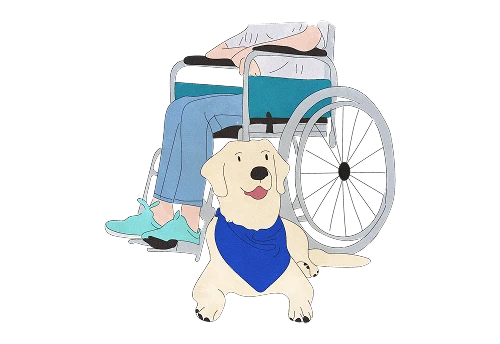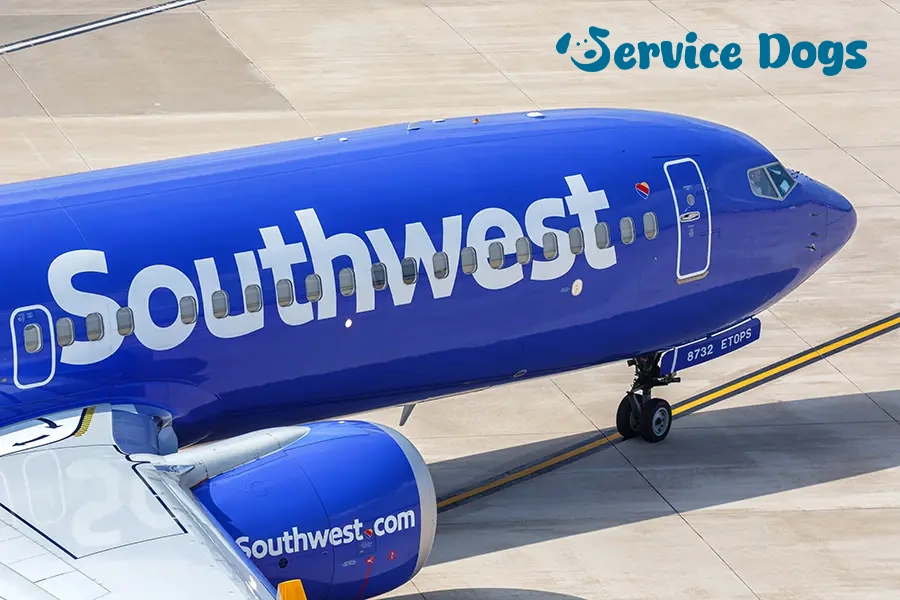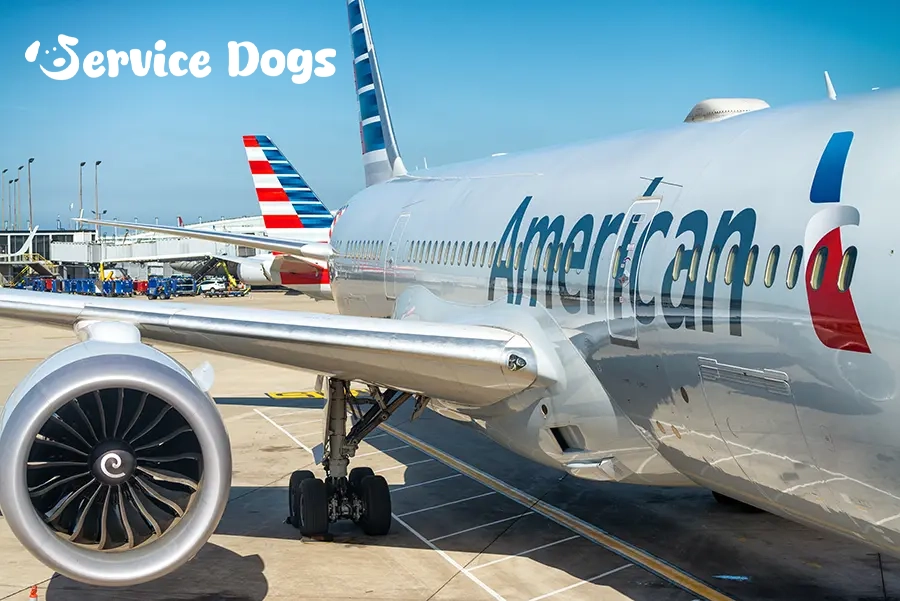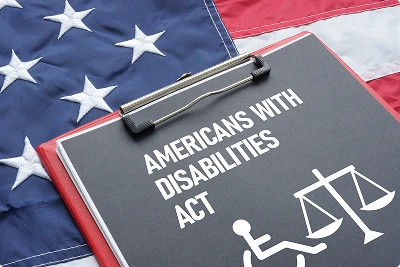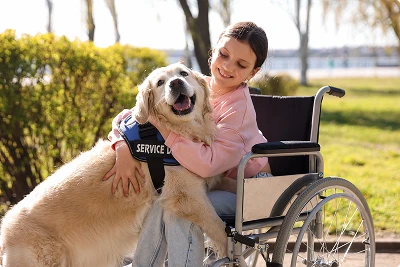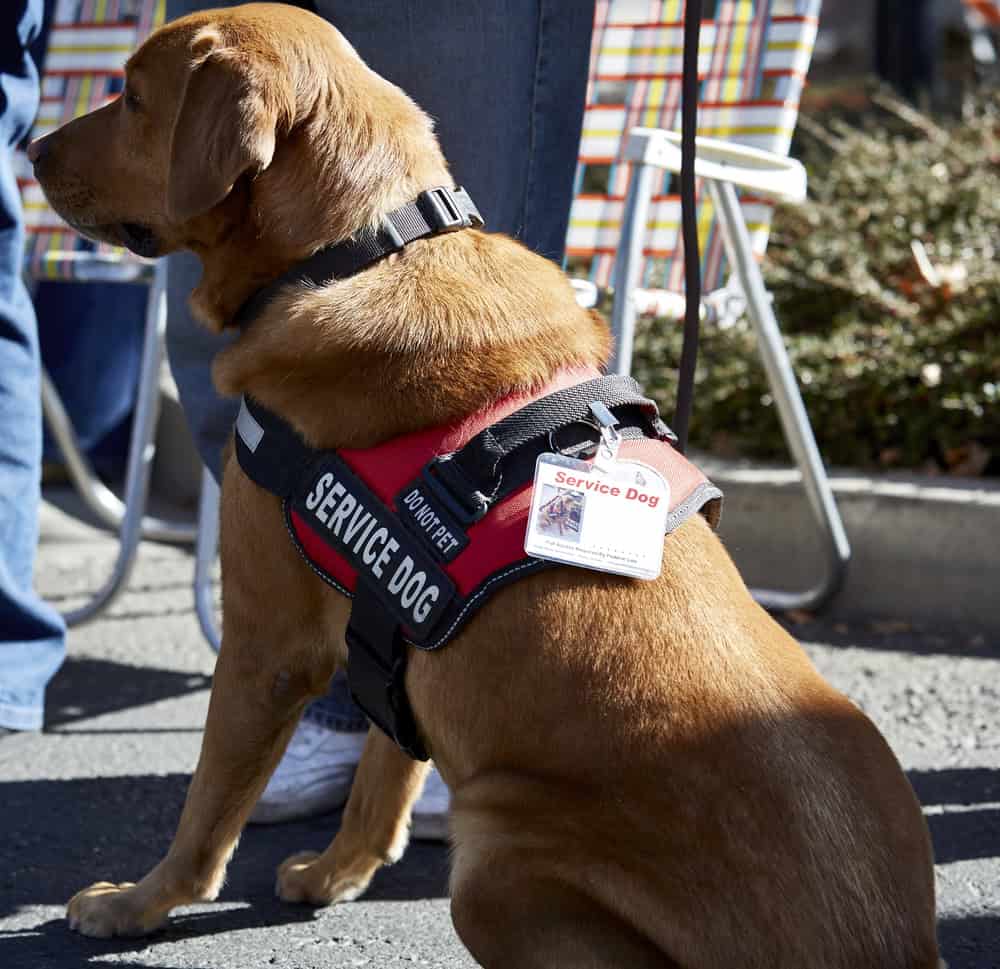Welcome to servicedogs.com
Your trusted resource for everything Service Dogs
Discover what service dogs are, how to get service dogs, what you need to know about service dog training, and what are the differences between service dogs, emotional support animals, and therapy animals.
Do you qualify for a psychiatric service dog?
How to get a service dog

Meet ADA Disability Requirements
Under the Americans with Disabilities Act (ADA), a disability is a physical or mental impairment that substantially limits one or more major life activities. You must have such a disability to legally qualify for a service dog. This is the foundational requirement upon which all other steps are built.

Train Your Dog for Disability-Specific Tasks
A service dog must be individually trained to perform specific work or tasks directly related to your disability. This is what separates a service dog from an emotional support animal. These tasks can range from guiding the blind to retrieving items or alerting to a medical crisis.

Choose Your Service Dog Training Method
You have options for training. You can train the dog yourself (owner-training), hire a professional trainer to assist you, or obtain a fully trained dog from a specialized organization. Each path has its own costs, timelines, and level of personal involvement.

Service Dog Public Access Skills
In addition to its specific tasks, a service dog must be trained to behave impeccably in public. This includes staying calm, not getting distracted by people or other animals, and remaining under your control at all times without being a nuisance or a threat.
What are the Types of Service Dogs?
Psychiatric Service Dogs
Assist individuals with mental health conditions by performing tasks like interrupting anxiety attacks. These dogs provide calming pressure during times of distress, and help ground their handlers.
Allergy Detection Dogs
Trained to sniff out and alert their handlers to the presence of specific allergens, helping prevent dangerous adverse reactions, like anaphylactic shock.
Autism Service Dogs
Offer safety, comfort, and assistance to individuals with autism by helping with social interactions, preventing wandering, and reducing anxiety.
Diabetic Alert Dogs
Detect changes in blood sugar levels and alert their handler to rising or falling glucose before it becomes dangerous.
Guide Dogs
Help people who are visually impaired move safely by avoiding obstacles and guiding them through public spaces.
Hearing Dogs
Alert individuals who are deaf or hard of hearing to important sounds like doorbells, alarms, or someone calling their name.
Mobility Assistance Dogs
Assist people with physical disabilities by retrieving items, opening doors, helping with balance, or pulling wheelchairs.
Seizure Alert Dogs
Some dogs develop the ability to sense an oncoming seizure and can alert their handler or help keep them safe during an episode.
Medical Alert Dogs
Provide warnings for a variety of medical conditions, such as detecting migraines, narcolepsy episodes, or severe allergic reactions.
Counterbalance Service Dog
Help individuals with balance issues by providing physical support to steady their handler while walking or standing.
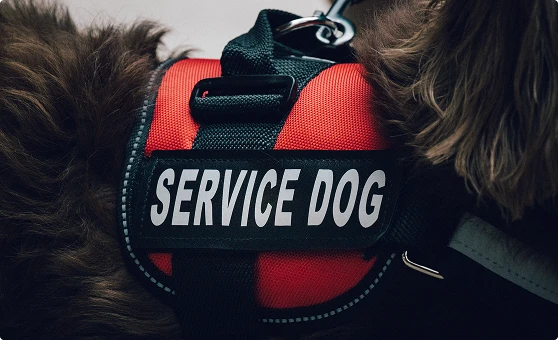

Service Dog Vest
A service dog vest is a piece of equipment that identifies a dog as a working animal, signaling to the public that the dog is performing important tasks for its handler. While a vest can help reduce unwanted interactions and make public access smoother, it’s not legally required under the Americans with Disabilities Act (ADA). Service dogs are defined by the tasks they perform, not by what they wear. However, many handlers choose to use a vest to avoid confusion and ensure their dog is recognized as a service animal rather than a pet.
Service dogs vests
Service Dog ID Tags
A service dog ID tag is an accessory that displays information identifying a dog as a service animal, often including the handler’s name and emergency contacts. While ID tags can help communicate that a dog is working and discourage unnecessary questions or distractions, they’re not legally required under the Americans with Disabilities Act (ADA). Service dogs don’t need any special ID or registration to have public access rights; their legitimacy comes from the specific tasks they perform for their handler’s disability. However, many handlers choose to use ID tags for convenience, safety, and peace of mind.
Service dogs vests
Suggested Readings
FAQ Section
How to train your service dog?
Service dogs can be trained by their handler, a professional trainer, or obtained through organizations that specialize in training service animals. Regardless of who does the training, every service dog must be individually trained to perform specific tasks that directly relate to their handler’s disability. These dogs must also learn to remain calm, polite, and focused in public places. While some people successfully train their own service dog, working with an experienced professional often yields the best results. A qualified trainer can tailor the dog’s skills to your unique needs (whether that’s retrieving items, providing balance support, interrupting panic attacks, or alerting to medical conditions) ensuring your service dog is reliable and confident in any situation.
What organizations train service dogs?
Many organizations, both nonprofit and for-profit, specialize in training service dogs for specific types of work, such as guide dogs for the visually impaired, psychiatric service dogs, mobility assistance dogs, and more. These organizations carefully train dogs to perform tasks tailored to various disabilities, ensuring they’re well-prepared to support their future handlers. Training a service dog can be expensive, and many organizations charge fees to cover these costs. However, there are nonprofit groups dedicated to providing service dogs at low or no cost, particularly for individuals with disabilities who meet certain qualifications. These nonprofits focus on making life-changing service dogs accessible to those who need them most.
What are service dog training requirements?
Service dogs must be individually trained to perform specific tasks directly related to their handler’s disability, such as retrieving items, guiding through crowds, or alerting to medical conditions. Beyond task training, they must be well-behaved, calm, and able to focus in public without posing a threat or disruption. While there’s no official certification required under federal law, proper training is essential to ensure a service dog can reliably assist its handler and navigate public spaces safely.
What is a psychiatric service dog?
A psychiatric service dog (PSD) is a specially trained assistance animal that performs specific tasks for individuals living with mental health conditions. These tasks are directly related to the handler’s disability and help mitigate its symptoms. People with diagnoses such as depression, anxiety disorders, PTSD, OCD, autism, bipolar disorder, social disorders (like agoraphobia or claustrophobia), schizophrenia, and more may benefit from a PSD. These dogs can provide tactile stimulation and pressure therapy, helping to ground their handler and offer therapeutic distraction. For example, a psychiatric service dog might apply gentle pressure to their handler’s chest or lap to promote emotional regulation and bring calm during moments of distress. Get your PSD here
How much do service dogs cost?
The cost of a service dog can vary widely, often ranging from $15,000 to $50,000 or more, depending on the type of tasks the dog is trained to perform and the organization providing the training. This price includes expenses like breeding, intensive training, veterinary care, and ongoing support. While some nonprofits help reduce or cover these costs for individuals with disabilities, it’s important to plan for additional expenses such as food, regular vet visits, and equipment over the dog’s lifetime. People can always purchase dogs and train them by themselves, and adopting dogs from shelters is another great alternative. There are many success stories of shelter dogs who successfully trained as service dogs.
What is an emotional support animal?
An emotional support animal (ESA), sometimes called a companion animal, is a pet that provides comfort and emotional support to its owner simply through its presence. Unlike service dogs, ESAs are not trained to perform specific tasks related to a disability, but they help reduce feelings of stress, anxiety, or loneliness by offering companionship and emotional stability. Only a licensed professional (such as a mental health specialist, therapist, counselor, or primary care physician) can designate a pet as an emotional support animal after conducting a thorough psychological evaluation of the individual seeking support, and prescribing them as part of a patient’s treatment plan. Get your ESA here
What is the difference between a service animal and an emotional support animal?
Service animals are specially trained assistance animals that perform specific tasks to help individuals manage their disabilities and navigate daily life safely and independently. In contrast, emotional support animals (ESAs) provide comfort and emotional stability simply through their presence, without being trained to perform particular tasks related to a disability.
Under the Americans with Disabilities Act (ADA), only dogs (and in rare cases, miniature horses) qualify as service animals. Emotional support animals, however, must be prescribed by a licensed medical or mental health professional, and many different types of animals can serve as ESAs, including dogs, cats, rabbits, and more. Unlike service animals, ESAs do not have the same public access rights but can qualify for housing accommodations under laws like the Fair Housing Act.
What is the difference between a service dog and a therapy animal?
A service dog is specially trained to perform specific tasks that help an individual manage a disability, giving their handler greater independence and support in daily life. In contrast, a therapy animal provides comfort and emotional support to many people in settings like hospitals, schools, or nursing homes but is not trained to assist a specific person with a disability. While service dogs have legal public access rights under laws like the ADA, therapy animals do not have the same access privileges and are only allowed in places where they’re invited or permitted as part of therapeutic programs.
Are service dogs permitted in public transportation?
Yes, service dogs are allowed on public transportation, including buses, trains, subways, and other transit systems. Under federal laws like the ADA, they have the right to accompany their handlers anywhere the public is allowed, ensuring individuals with disabilities can travel safely and independently.
When are service dogs not allowed in public places?
Service dogs can be denied access to public places under two circumstances:
- If the dog is out of control and the handler cannot effectively manage its behavior. For instance, if the dog is barking excessively, acting aggressively, or otherwise posing a threat or nuisance to others.
- If the dog is not housebroken, meaning it cannot reliably control its bathroom needs in public spaces.
Even though service dogs have broad public access rights, businesses and facilities are permitted to ask a handler to remove a dog that falls into either of these categories. Service dogs cannot be discriminated against if someone is allergic or scared of them.
Do service dogs in training have the same legal rights as fully trained service dogs?
No, at a federal level service dogs in training do not have the same legal protections as fully trained service dogs. There are instances of state laws that extend certain rights to service dogs in training as well, but in general, service dogs in training are not considered service dogs.


